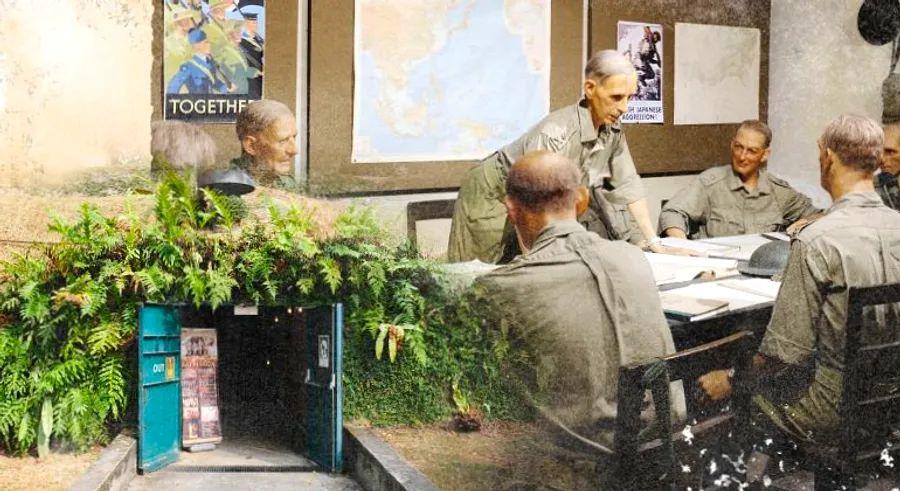Uncover Singapore's hidden military history.

In the shadowy underground bunker, 12 military leaders prepare to execute the largest surrender in British military history.
At 9:45 a.m. on February 15, 1942, Lt. Gen. Arthur Percival and 11 senior officers decided to surrender the British forces—over 120,000 men across Malaysia and Singapore—to the Japanese, whose numbers were barely half that size.
This pivotal moment occurred inside 'The Battlebox,' a secret, heavily fortified bunker beneath Fort Canning Hill in Singapore, now a museum.
After 70 days of relentless jungle combat, Percival’s forces were depleted—low on supplies, ammunition, and morale.
'The defense of Singapore was the cornerstone of the British Empire’s strategy in Asia. From here, Britain could control its entire Asian domain,' says Battlebox director Jeya Ayadurai. But surrender quickly emerged as the only viable option.
Percival’s decision marked not only the darkest moment in Singapore’s history but also set in motion the decline of the British Empire.
Today, Singapore has risen as a global cultural and financial powerhouse, making its mark on the world stage.
As the city-state celebrated its bicentennial in 2019, shifting the narrative surrounding the past became crucial as Singapore looked forward to its future, according to Ayadurai.
'There are many myths about the Battle of Singapore, and we felt it was essential to shed light on the real reasons behind its fall. We wanted to focus on how modern Singapore looks to the future,' he adds.
An overlooked fortress
The British began their war preparations as soon as Japan invaded China in 1937.
'The Battlebox' refers to Fort Canning Bunker, built in 1938 as a secret, bomb-proof command center beneath Fort Canning Hill. This strategic hub became a center for British intelligence and high-level operations during the Malayan campaign and the Battle of Singapore, as British commanders grew increasingly concerned about Japanese advances.
However, Japan's victory was solidified in December 1941 when it opted to attack Singapore from Malaysia, rather than by sea, on the same day it launched the assault on Pearl Harbor.
While Percival and his team braced for an assault on Singapore’s northeastern defenses, the Japanese forces struck from the northwest, where the British were weakest.
The Battle of Singapore, also known as the Fall of Singapore, took place from February 8 to 15, 1942. Following the surrender of Singapore, the Japanese military took control of the Battlebox.
After World War II ended, the bunker was abandoned and forgotten for many years, its entrance concealed by thick undergrowth.
The site was rediscovered in the 1980s when a journalist stumbled upon it and published an article about its historical importance in Singapore’s *Straits Times* newspaper.
A Journey into History
The site reopened as a museum in 1997, marking the 55th anniversary of Singapore's surrender, and was later renovated by Singapore History Consultants, who have managed it since 2013.

The Battlebox serves to tell two crucial stories: the fall of Malaya and Singapore during WWII, and the operation of an underground command center during the conflict.
By doing so, Ayadurai aims to provide a 'window into a world that most civilians never knew existed.'
Deep within the bunker, lifelike wax soldiers stand guard in shadowy corridors, creating an eerie atmosphere. Guides lead visitors through the maze-like underground rooms, including the Plotting Room, the Cipher Office, and the Surrender Conference Room, all restored to their 1940s appearance.
In the Cipher Office, old equipment and scattered notes fill the desks, with Japanese characters marking key British figures scrawled across the walls. These remnants have been preserved behind glass. During the tour, the museum docent shares a story about how the toilets used by personnel became blocked as Singapore’s surrender loomed, worsening the already dire conditions for the British commanders.
The hardships of life in the dark, damp bunker during WWII are palpable.
Fostering a Culture of Remembrance
As Singapore focused on rapid development, the importance of commemorating its past was often neglected, according to Ayadurai.
'We became a first-world nation in a rush, driven by an intense focus on economic growth. However, we didn’t give much thought to preserving our memories,' he says.

The Battlebox’s mission arose from a desire to understand the complexities of war and foster a constructive dialogue about painful historical events. While not glossing over the harsh realities of conflict, Ayadurai emphasizes that the goal is to use commemoration as a tool to build a better future.
'We owe it to those who lived through the war, and those who served in it,' says Ayadurai. 'Our aim is not to glorify war, but to acknowledge it as a sacrifice and, where possible, to improve international relations and create a more peaceful world.'
In the future, the Battlebox plans to introduce new galleries focusing on the post-war era and Singapore’s journey to independence on August 9, 1965. For now, Ayadurai hopes the museum’s frozen figures and artifacts will help reshape perceptions of warfare.
'When you leave the Battlebox, your view of war will change. You’ll gain a deeper understanding of its complexities and the hardships these men endured. It gives you a new appreciation of what truly happened on a human level.'
The Battlebox, 2 Cox Terrace, Singapore 179622 +65 6338 6133

1

2

3

4

5
Evaluation :
5/5